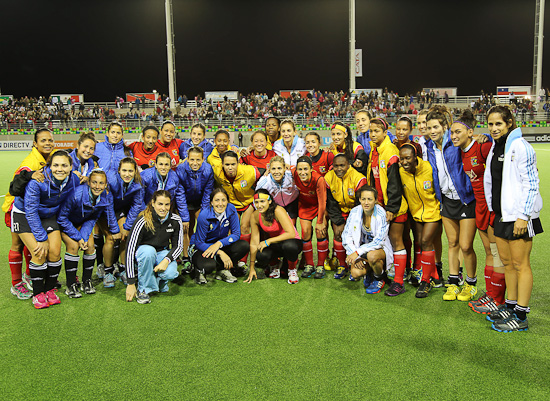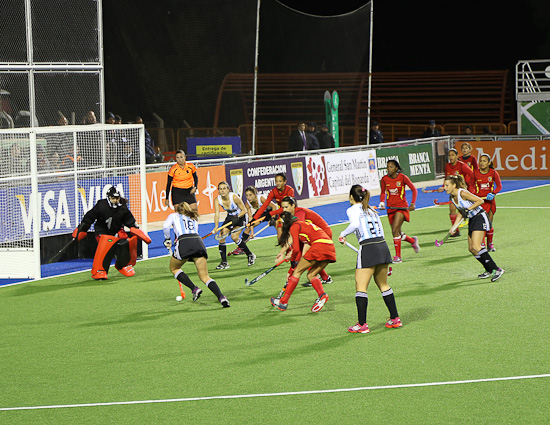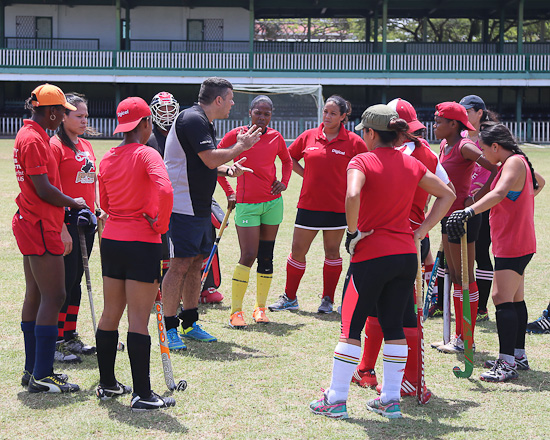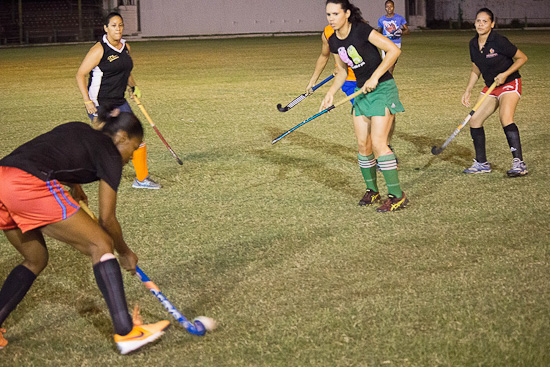
After enjoying international success in the 1960s through the early 80s, Guyana women’s hockey died off in the 90s due mainly to the migration of many of its key personnel. In 2000 however, ladies hockey re-emerged on the local calendar. Aside from a squad of players travelling to Trinidad for a weekend of matches in 2001 where they lost all of their matches against second division Trinidadian club sides, it would take until 2006 for Guyana to return to genuine international competition.
An invitation from Venezuela to participate in a Tri-nation tournament between the hosts, Venezuela, Brazil and Guyana was just the catalyst to re-introduce the Guyana ladies, many of whom had never even seen an artificial pitch, to regional competition. Brazil played unbeaten in the series and though Guyana and Venezuela competed in very close matches, Guyana edged the hosts to finish in second place. While none of these teams were ranked highly in PAHF rankings, Guyana would have been the least experience with none of its players having played in international competition.
Encouraged by their first outing, the Guyana ladies competed the following year in the PAHF Caribbean Cup 2007 in Trinidad against Trinidad, Barbados and Jamaica. The unfamiliar artificial pitch continued to be their most difficult challenge and the team performed increasingly better as the tournament progressed; a theme that would repeat itself many times in competitions to come. Guyana finished at the bottom of the standings and, despite encouraging results toward the end of the tournament, the absence of an artificial pitch in Guyana on which the team could train became increasingly evident as an impediment to success.
Despite being ranked as first reserve for the Central American and Caribbean games 2010, the circumstances of a withdrawal earned the Guyanese ladies their first ever opportunity to participate in the games. Guyana entered the competition of the CAC Games as the lowest ranked team and emerged in 6th place out of 8 teams. This was considered a huge success for a team expected to finish at the bottom.
After failing to qualify for the Pan American Games, which would have required a top three finish in the CAC Games, Guyana set its sights on the PAHF Challenge in Rio de Janeiro, Brazil in 2011. The PAHF Challenge is a qualifier for the PAHF Cup, the other major regional tournament on the PAHF calendar. To qualify for the PAHF Cup, the team would have to finish in one of the top two spots. While Guyana had begun to climb in the PAHF rankings, they would still remain at the bottom of the pool of teams at the PAHF Challenge. The five-team tournament featuring Guyana, Paraguay, Uruguay, Bermuda and hosts Brazil would see Guyana edge Brazil for a spot in the final against Uruguay. While it was clear that Guyana were no match for Uruguay, the result of the PAHF Challenge was a victory in itself as it earned Guyana a place to compete among the elite regional teams in the PAHF Cup in Mendoza, Argentina 2013.
With their sights firmly set on the PAHF Cup, the Guyanese ladies capitalized on the Hockey World League first round being staged in neighbouring Trinidad in 2012. Guyana placed 5th out of 6 teams in keeping with the teams’ rankings.
Despite some severe losses in the PAHF Cup including a crushing defeat by then reigning World Champions Argentina, Guyana showed that they were competitive with the teams in the lower half of the competition. The top teams were clearly at a different level and Guyana struggled against them. Guyanese goalkeeper Alysa Xavier was the team’s standout player at the tournament and became the first player from the country to be listed on a PAHF Elite team. The highlight of this tournament was for the Guyanese ladies to share the same pitch with superstar Luciana Aymar and Las Leonas.
This brought Guyana to the end of a cycle as the next step for the team is to participate in the CAC Games 2014 in Vera Cruz, Mexico. During this past cycle Guyana can boast of being the biggest climber on the FIH world rankings, moving from #58 in 2011 up to #38 by the end of 2013. The most notable aspect of this achievement is that the country remains one of very few who compete internationally without an artificial pitch on which to train.
Team Guyana continues to pursue its goals by training on natural grass cricket fields. This is often done by night as cricket is the nation’s number one sport and so field time is difficult to reserve during the daytime. Despite their inability to participate in both the World League and the CAC games in the same year, Guyana is no longer an unknown entity whom other teams take lightly. It has been more than a year since the Guyanese ladies have competed on the regional stage and the team is keen to match its skills against others in the upcoming Games.
The members of the Guyanese Federation are quick to mention that Guyana is grateful for the cooperation of some of its fellow regional nations in helping its women’s hockey team achieve their success. Firstly Venezuela and then Trinidad and Tobago, Barbados and Canada have all been welcoming to the South American minnows along the way, affording them much needed training and practice matches on artificial pitches. Guyana’s success continues to defy the odds as the ladies hockey team continues to make every effort in their current conditions with the hope of one day securing the opportunity of having a field hockey pitch installed in Guyana.



